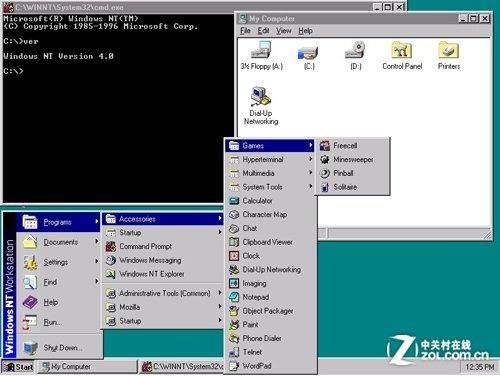Windows NT 4.0的MS-DOS工作站
Posted
tags:
篇首语:本文由小常识网(cha138.com)小编为大家整理,主要介绍了Windows NT 4.0的MS-DOS工作站相关的知识,希望对你有一定的参考价值。
参考技术A目前,许多单位有大量的486微机仍在使用中,且有不少的DOS应用程序在使用,较难快速将工作站操作系统转换为Windows 95或Windows NT Workstation。因此为了一方面要保证网络操作系统能使用主流的Windows NT,另一方面又要兼顾现实的情况,就必须解决好Windows NT 4.0下DOS工作站的配置问题。
本文详细介绍Windows NT 4.0下DOS工作站的配置方法及步骤。 方法1:可以在中文Windows NT Server 4.0服务器上通过“开始→程序→管理工具→网络客户管理器”,选择“制作安装磁盘组”中的“LAN Manager v2.0 for MS-DOS”进行制作。
方法2:直接通过“资源管理器”进入“中文Windows NT Server 4.0”操作系统的安装光盘,将“Client→Lanman→Disks”目录下的“Disk1”、“Disk2”、“Disk3”、“Disk4”子目录下的内容分别拷贝到四张1.44M软盘中即可。将LAN Manager v2.0安装到DOS工作站
步骤1:将“LAN Manager v2.0”安装盘的第一张磁盘插入磁盘驱动器中,并在该驱动器运行SETUP程序。当出现“Microsoft LAN Manager v2.0 SETUP”画面后按“Enter”键。
步骤2:出现“Using the keyboard in setup”画面时按“Enter”键。
步骤3:出现“Install LAN Manager”画面时,若认可安装是从“A:”驱动器进行,并且认可安装目标目录为“C:\\LANMAN.DOS”时按“Enter”键。否则,用鼠标或通过“TAB”键将光标移到相应位置进行修改并按“Enter”键确认。
步骤4:出现“Install LAN Manager”画面时,若认可安装是从“A:”驱动器进行,并且认可安装目标目录为“C:\\LANMAN.DOS”时按“Enter”键。否则,用鼠标或通过“TAB”键将光标移到相应位置进行修改并按“Enter”键确认。
步骤5:出现“Install LAN Manager”之“What do you want to install?”画面时,可直接按“Enter”键选择“LAN Manager Enhanced”安装方式。亦可选择“LAN Manager Basic”安装方式(该方式可节约内存,但它所提供的功能较少)。
步骤6:出现“Insert Disk”之“DOS Drivers 1 in drive A”时将安装盘2换入软驱中,并按“Enter”键。
步骤7:出现“Network Adapter Drivers”之画面时,请从“Select Available Network Adapter Driver”列表中选择合适网卡驱动程序。当列表中不包括网卡驱动程序时,按“Alt+D”键使用“Other Driver”选项配置网卡,同时将包含网卡驱动程序的安装盘换入软驱中,并按“Enter”键。在“Other Network Adapter Drivers”画面中选定并确认网卡驱动程序。之后,在“Network Protocol for”画面中以光标加“空格”键选择网络通讯协议(一般采用Netbeui协议)以安装网卡驱动程序及网络通讯协议。
步骤8:出现“Workstation Settings”之画面时,请在“Computername”选项中输入计算机名,在“Username”选项中输入用户名,在“Domain”中输入计算机所在主域域名,在“Other Domains to Monitor”中输入计算机所在其他域域名或工作组名称(此项可不输)。按“Enter”确认以上各选项有效。
步骤9:出现“Support for Windows Environment”之画面时,请在“Run MS-DOS LAN Manager with the Windows Environment?”选项中用光标选择“Yes”或“No”以确定是否在MS-DOS及Windows中与网络连接。
步骤10:当选中“Yes”确定是在MS-DOS及Windows中与网络连接时,请在出现“Windows Directory”画面中的“Windows Directory[]”选项填入Windows的路径。
步骤11:在出现“Messaging Popup”画面的选项中选定你是否在Windows及MS-DOS环境下都能运行网络程序。同时在“Configuration Complete”画面保存以上配置。
步骤12:在出现“Insert Disk DOS DRⅣERS 2 in driver A:”画面时,换入“LAN Manager”的第三张盘继续安装至结束。
至此,在CONFIG.SYS文件中会包含类似如下几行命令:
DEviCE=C:\\LANMAN.DOS\\DRivERS\\DOSUTILS\\EMM386.EXENOEMS
LASTDRivE=Z
DOS=HIGH,UMB
DEviCE=C:\\LANMAN.DOS\\DRivERS\\PROTMAN\\PROTMAN.DOS/i:
C:\\LANMAN.DOS
DEviCE=C:\\LANMAN.DOS\\DRivERS\\ETHERNET\\ELNK3\\ELNK3.DOS
(此以3C509网卡为例)
在AUTOEXEC.BAT文件中会包含类似如下几行命令:
SET PATH=C:\\LANMAN.DOS\\NETPROG;%PATH%
NET START WORKSTATION
LOAD NETBEUI
[注]若每次开机均要求登录,在此行之下加:
NET LOGON *配置LAN Manager v2.0的DOS工作站在完成以上安装后重新启动DOS工作站,并记录下“Activating adapter at I/O Port=0x???,INT=xx”即网卡的I/O地址及中断号。然后,用“EDIT”或其他编辑器对“C:\\LANMAN.DOS\\PROTOCOL.INI”进行相应的修改。具体做法如下:
在PROTOCOL.INI文件中[NETBEUI_xiF]组里的
DRivERNAME=ELNK3$(此仍以3C509网卡为例)
;2nd driver name=ELNK32$
之下加上
;INTERRUPT=xx(xx为启动时所见到的中断号INT)
;IOADDRESS=0x???(0x???为启动时所见到的地址I/O Port)
重新启动即可完成配置安装。
当工作站是IBM300GL等自带以太网卡的原装PC机时:
需要将PROTOCOL.INI文件[NETBEUI_xiF]组中
BINDINGS=“XXXXXX”所指向的那个组中的
;Sample Protocol.INI
[MS$CRYSTAL]
二行删除,并在
DRivERNAME=XXXXXXX
之下加上
;INTERRUPT=xx(xx为启动时所见到的中断号INT)
;IOADDRESS=0x???(0x???为启动时所见到的地址I/O Port)
重新启动即可完成配置安装。
⒌配置LAN Manager v2.0的网络命令:
1NET
运行网络连接程序
2NET/?
查看NET命令的用法
3NET LOGON
登录网络
4NET LOGOFF
注销网络
5NET viEW \\\\NTSERVER
观察服务器NTSERVER中的共享资源
6NET USE F:\\\\NTSERVER\\WORK
将网络驱动器F:连接到服务器NTSERVER中的共享资源,其共享名称为WORK
7NET USE
观察网络驱动器及网络打印机连接状况
8NET USE F:/DELETE
删除网络驱动器F:
9NET USE LPTn: \\\\NTSERVER\\HP-4VC
将服务器NTSERVER上的HP-4VC作为网络共享打印机连接到本机的LPTn端口上
10NET USE LPTn: \\\\NTSERVER\\HP-4VC/PERSISTENT:NO
更改网络打印机连接设置
11 NET USE LPTn: /DELETE
中断所连接的网络打印机

第一章 Windows NT System Components
Page 3.
The focus(焦点) of this book is Windows NT file system and the interaction(交互) of the file system with the other core(核心) operating system components(组件,部分).If you are interested in providing(提供) value-added(增值) software for the Windows NT platform(平台), the topics(主题) on filter(过滤) driver design and development(发展) should provide(提供) you with a good understanding of some of the mechanics involved(有关的) in designing such software.
Files systems and filter drivers don‘t exist in a vacuum(空间), but interact(相互影响) heavily(严重的) with the rest of the operating system. This chapter(章节) provides(提供) an overview(概述) of the main components(部分) of the Windows NT operating system.
The Basics(基础,基本要素)
Operating systems deal(处理) with issues(问题) that users prefer(更喜欢) to forget, including initializing(正在初始化) processor(处理器) states, coordinating(协调) multiple(多重) CPUs, maintaining(维护) CPU cache coherency(缓存一致性),managing(管理) the local bus(局部总线), managing physical(物理) memory, providing(提供) virtual memory support(支持), dealing with(处理) external(外部) devices(设备),defining(定义) and scheduling(调度) user processes/threads, managing user data stored(存储) on external(外部) devices(设备), and providing(以及提供) the foundation(基础) for an easily manageable(容易控制) and user-friendly computing(计算) system. Above all(首先尤其是), the operating system must be perceived as(被看作) reliable(可靠) and efficient(有效), since any perceived(认为) lack(缺乏) of these qualities(品质) will almost certainly(肯定) result in the universal(普遍的) rejection(排斥) and thereby(因此) in the quick(快速) death of the operating sysytem.
Contrary(相反) to what you are may have heard(听到), Windows NT is not a state-of-the-art(最先进) operating system by any means(无论如何). It employs(使用) concepts(概念) and principles(原则) that have been know(已经知道) for years(好几年) and have actually been implemented(实际上已经被实现) in many other commercial(商用) operating systems. You can envision(想象) the Windows NT platform as the result(结果表明) of a confluence(汇合) of ideas(思想的汇合), principles(原则), and practices(实践) obtained(获得) from a wide Variety of (多种多样的)\
Page 4.
sources(来源), from both commercial products (从商业产品)and research(研究) projects conducted(管理) by universities(大学).
{ 恰恰相反你也许会听到,Windows NT 无论如何也不是最先进的操作系统,它使用的概念和原则已经被一些商用的操作系统在好几年前就被实现了。你可以想象认为 Windows NT 平台是商业产品和大学项目研究等多种多样思想,原则,实践的汇合的结果 }
Design principles(设计原则) and methodologies(方法) from the venerable(珍贵的) UNIX and OpenVMS operating system platforms, as well as the MACH operating system developed(开发) at CMU, are obvious(明显的) in Windows NT. You can also see the influence(影响) of less sophisticated(复杂) system, such as MS-DOS and OS/2. However, do not be misled into thinking that Windows NT can be dismissed as just another conglomeration(聚合) of rehashed(重复) design principles(设计原则) and ideas. The fact that the designers of Windows NT were willing(乐意) to learn from their own experiences(经验) in designers other operating systems and the experiences of others has led(指引) to the development of a fairly stable(较稳定) and serious(严重) computing platform.
{在Windows NT 的设计原则和方法很明显的来自 珍贵的UNIX和OpenVMS操作系统,也有来自卡耐基梅隆大学开发的MACH操作系统。你也可以看到影响不那么复杂的系统,例如MS-DOS 和 OS/2。然而,不要被误导认为Windows NT 可以使另一个的重复设计原则和想法的聚合。事实上Windows NT乐意学习这些操作系统的是经验,并且用这些经验来指引开发稳定和严重的计算平台。}
The Core Architecture(核心架构)
Certain(某些) philosophies(哲学) derived(派生的) from the MACH operating system are visible in(是可见的) the design of Windows NT . These include an effort(努力/成就) to minimize(最小化) the size of the kernel and to implement(实现) parts of the operating system using the client-server model, with a message-passing(消息传递) method(方法) to transfer(转移) information between modules(模块,组件). Furthermore(此外), the designers have tried to(试图) implement(实现) a layered(分层) operating system, where each component(组件) interacts(交互) with other layers via a well-defined interface(接口).
{在Windows NT 操作系统中可见某些设计哲学来自MACK操作系,这些成就包括操作系统使用CS模式实现一个最小的内核,模块之间使用消息传递来转移信息。此外,设计试图实现一个分层的系统,让组件通过分层之间良好的接口进行交互。}
The operating system was designed specifically to(专门) run in both single-processor(单处理器) and symmetric(对称) multiprocessor(多重处理器) environments(环境).
{ 这个操作系统专门用来运行在双核处理器和对称的多核处理器环境 }
Finally, one of the(其中之一) primary(主要) goals(目的) was to make the operating system easily portable across(容易移植) many different hardware(硬件) architectures(架构). The designers tried to(试图) achieve this goal by using an object-based(基于对象) model to design operating system components and by abstracting out(通过提取) those small pieces(块) of the operating system that are hardware-dependent(硬件相关) and therefore(因此) need to be reimplemented(重载实现) for each supported(被支持的) platform; the more portable components(便携式组件) can, theoretically(理论上), simply be recompiled(重新编译) for the different architectures(架构).
{最后,其中最主要的一个目的之一是做一个在不同硬件架构上容易移植的操作系统。设计试图实现这个目标使用基于对象模式来设计操作系统组件并且通过提取操作系统和相关硬件的最小块。因此需要中再来实现这些被支持的平台,更多的便携式组件,理论上,只要在不用的架构上简单的编译。}
Figure(图) 1-1 illustrates(说明) how the Windows NT operating system is structured.(结构) The figure shows that Windows NT can be broadly(明显的) divided into two main components: user mode and kernel mode.
{图1-1说明了Windows NT操作系统结构是什么样子的,这个图展示Windows NT 可以明显的分为两个部分:用户模式和内核模式}
User mode
The operating system provides(提供) support(支持) for protected subsystems. Each protected subsystem resides(存在) in its own process with its memory protected from other subsystems. Memory protection(保护) support is provided(提供) by the Windows NT Virtual Memory Manager.
{操作系统提供支持保护子系统,每一个保护子系统存在它自己的内存保护和其它的子系统。内存保护支持来自Windows NT的虚拟内存}
以上是关于Windows NT 4.0的MS-DOS工作站的主要内容,如果未能解决你的问题,请参考以下文章